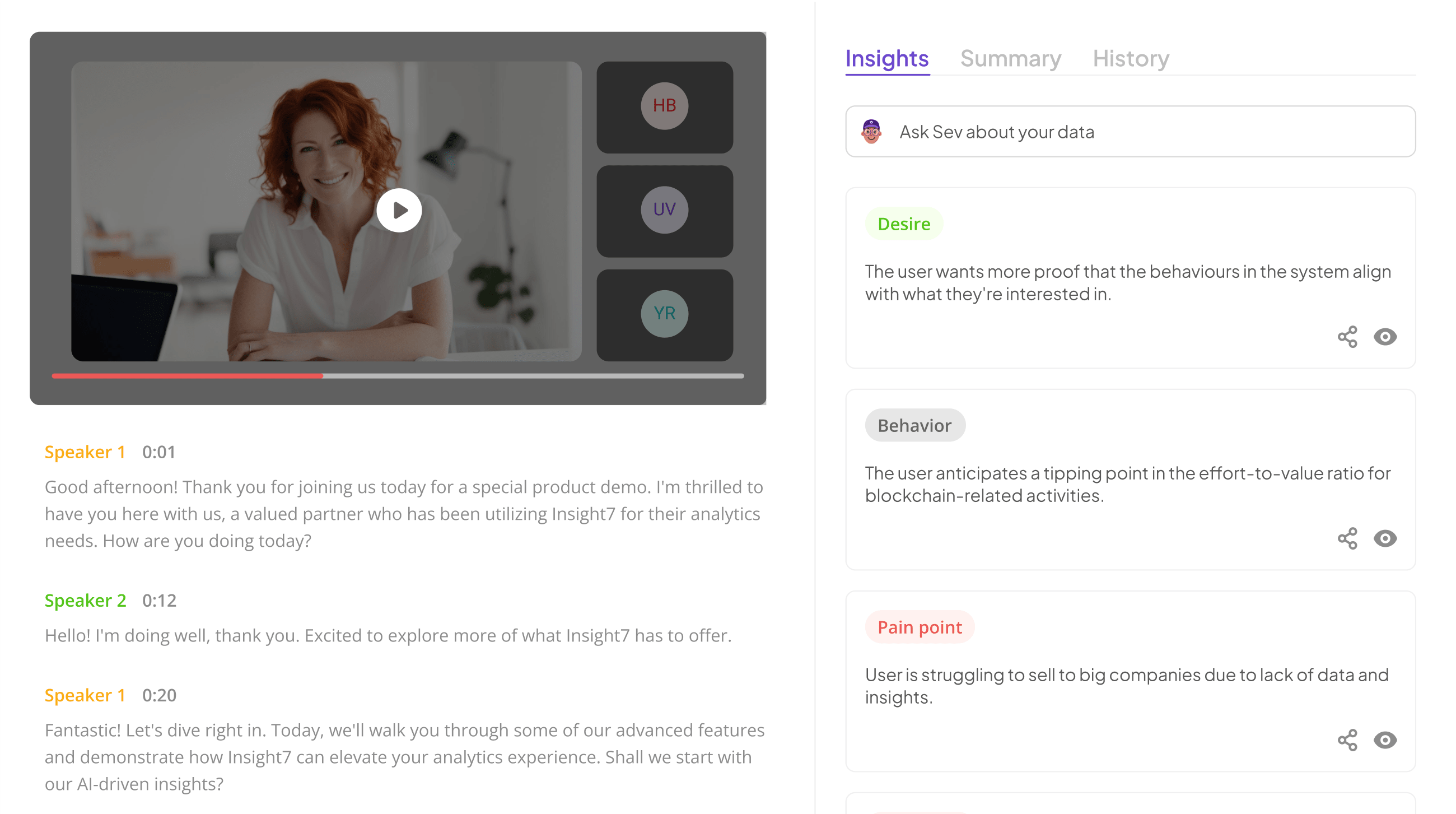Stakeholder Interview Analysis: How-to & Top Tools
-
Bella Williams
- 10 min read
Stakeholder insights tools are essential in crafting meaningful conversations and gathering vital feedback. When utilized effectively, these tools transform interviews into rich, actionable data that uncover stakeholders' needs and preferences. By engaging with stakeholders directly, organizations can better understand the nuances behind their feedback, ensuring that insights are not just collected but effectively analyzed for maximum impact.
This section introduces the methodology behind stakeholder interview analysis, emphasizing the importance of reliable tools. The right stakeholder insights tools empower teams to streamline the analysis process, detect trends, and drive strategic decisions based on solid evidence. Understanding the various tools available enables organizations to select those that best fit their objectives, fostering an insightful environment that promotes growth and innovation.
Analyze & Evaluate Calls. At Scale.

Step-by-Step Guide to Effective Stakeholder Interview Analysis
Effective Stakeholder Interview Analysis requires a systematic approach to extract valuable insights. Begin by defining clear objectives for your interviews. Understanding the specific information you need from stakeholders sets the foundation for productive sessions. Next, prepare thoughtful questions that encourage candid responses. Balancing open-ended queries with focused prompts enhances the depth of your data.
After conducting the interviews, transcription and data compilation become essential for thorough analysis. Utilize Stakeholder Insights Tools to categorize findings, identifying themes and patterns. For instance, software solutions can help visualize results, making it easier to derive actionable insights. Lastly, evaluate the data against your predefined objectives, ensuring that the analysis aligns with your project's strategic goals. This structured method fosters effective analysis, paving the way for informed decision-making based on comprehensive stakeholder feedback.
Understanding Stakeholder Needs
Understanding stakeholder needs is crucial for aligning project goals and fostering mutual understanding among all parties involved. Engaging effectively with stakeholders allows you to capture their motivations, concerns, and preferences. This interaction empowers you to tailor solutions that resonate with their expectations and drives project success.
To efficiently gather stakeholder insights, it's beneficial to utilize various Stakeholder Insights Tools. These tools streamline data collection, enhance analysis, and provide real-time feedback. Start by transcribing interviews to create comprehensive records. Next, analyze these records for recurring themes and sentiments. Finally, generate reports that summarize findings, enabling you to present actionable recommendations that address stakeholder needs effectively. Emphasizing a consultative approach in your interactions strengthens relationships and ensures that solutions align better with stakeholder expectations and market dynamics.
Collecting and Compiling Data for Stakeholder Insights
Collecting and compiling data for stakeholder insights involves strategic methods to gather and interpret perspectives effectively. When approaching this task, it is essential to ensure that every captured detail contributes to understanding stakeholder needs comprehensively. Utilizing Stakeholder Insights Tools can help simplify this process, making data collection both efficient and insightful.
Start by gathering qualitative data through interviews and discussions, documenting key themes and sentiments expressed by stakeholders. This information can then be analyzed using specialized tools to identify common pain points and desired outcomes. Another effective method is to categorize the gathered data into actionable segments, allowing for easy reference and analysis. By leveraging the capabilities of insights tools, teams can visualize trends and make informed decisions that resonate with stakeholder needs, ultimately leading to improved engagement and satisfaction.
Stakeholder Insights Tools for Analysis
In the realm of stakeholder interview analysis, utilizing effective tools is crucial for extracting actionable insights. Stakeholder insights tools enable organizations to streamline the process of gathering, analyzing, and interpreting data from interviews. The variety of tools available allows users to easily compile information, visualize findings, and identify key patterns that inform decision-making. These tools democratize access to insights, ensuring that team members from various departments can contribute and respond to stakeholder needs.
When selecting stakeholder insights tools, consider features such as ease of use, the ability to visualize data, and options for collaborative work. The tools should allow for efficient transcription of interviews, highlight pain points, and categorize insights meaningfully. By investing in the right tools, organizations can transform raw interview data into valuable insights that guide strategy and improve stakeholder engagement. Effective analysis hinges on selecting tools that align with specific objectives and enhance the overall understanding of stakeholder perspectives.
Extract insights from interviews, calls, surveys and reviews for insights in minutes
Top Stakeholder Insights Tools Overview
In navigating the realm of stakeholder interview analysis, utilizing the right tools can significantly enhance the effectiveness of your insights gathering process. Stakeholder insights tools are designed to streamline data collection, visualization, and analysis, making the entire experience more intuitive and informative. They provide a structured approach for interpreting detailed stakeholder feedback, enabling you to extract valuable themes, pain points, and customer experiences with ease.
Several leading tools stand out in this space. Insight7 is a comprehensive platform that facilitates seamless data handling and insightful reporting. Dovetail offers an efficient interface dedicated to interview transcription and analysis. Meanwhile, Airtable allows for organized handling of qualitative data, while Miro focuses on collaborative stakeholder mapping. Lastly, Trello aids in visualizing tasks and maintaining oversight on insights track. Together, these tools equip you with varied capabilities to transform stakeholder input into actionable insights, ultimately leading to more informed decision-making.
- insight7: The Comprehensive Stakeholder Insights Tool
With insight7, users gain access to an extensive platform designed to streamline the gathering and analysis of stakeholder insights. This tool empowers all team members, regardless of expertise, to extract valuable data from interviews or customer feedback easily. The platform allows users to transcribe calls, visualize conversations, and pinpoint pain points or desires, ultimately demystifying stakeholder analysis.
insight7 features a user-friendly library where recorded interactions can be filed and analyzed efficiently. Users can generate actionable insights by summarizing responses, identifying themes, and reviewing evidence from stakeholders directly. This holistic approach ensures that decision-makers are equipped with comprehensive information, making it easier to address concerns or improve experiences across the board. By centralizing these processes, insight7 transforms the way organizations engage with stakeholder insights, fostering effective solutions and communication channels.
- Dovetail: Efficient Interview Analysis Platform
The efficient analysis of stakeholder interviews serves as a cornerstone for understanding customer feedback and aligning business strategies accordingly. In today’s ever-evolving market, organizations are inundated with conversations and insights that can influence their path forward. A dedicated interview analysis platform simplifies this process, transforming raw data into actionable stakeholder insights.
With advanced features like automated transcription and thematic coding, this platform allows for a more fluid approach to data analysis. Users can easily navigate through interview data, extracting relevant findings quickly, which helps in making informed decisions. The integration of collaborative tools ensures that team members can work together seamlessly, ensuring insights are shared and actioned promptly. By streamlining the analysis of stakeholder interviews, organizations position themselves to not only respond to market needs efficiently but also to anticipate them, setting the stage for sustained growth.
- Airtable: Organizing and Analyzing Qualitative Data
Airtable stands out as an exceptional platform for managing and interpreting qualitative data gathered from stakeholder interviews. This tool allows you to consolidate various types of data, such as transcripts, quotes, and insights, into a single, accessible project. By organizing these elements in a structured manner, you can quickly extract meaningful patterns from extensive discussions, enhancing your ability to derive actionable insights.
One of the key features of Airtable is its intuitive interface that facilitates the creation of projects. Here, you can upload files directly from your computer or integrate with platforms like Google Drive. Once your data is assembled, you can utilize the matrix functionality to compare responses and identify trends across different interviews. This capability greatly simplifies the process of analyzing stakeholder feedback, making Airtable a valuable tool in your arsenal for gathering and organizing stakeholder insights effectively.
- Miro: Collaborative Stakeholder Mapping
Miro provides an intuitive platform for collaborative stakeholder mapping, allowing teams to visualize and analyze their stakeholder relationships effectively. This digital whiteboard tool facilitates brainstorming and engaging discussions, making it easy to record insights obtained from interviews and surveys. By mapping stakeholder interactions and influences in real-time, users can identify key connections and potential areas for engagement, enhancing the overall understanding of stakeholder dynamics.
In creating a stakeholder map, it’s crucial to include various elements such as stakeholder roles, interests, and levels of influence. Teams can collaboratively annotate and adjust this map as new insights emerge, fostering a more dynamic analysis process. Miro’s features, like sticky notes, templates, and integration capabilities, streamline the organization of information, thereby simplifying the journey from data collection to actionable strategies. This collaborative approach enables organizations to align their goals with stakeholder expectations, ultimately leading to more effective engagement strategies.
- Trello: Visual Task and Insight Tracking
Trello serves as an engaging platform for visual task and insight tracking, ideal for managing stakeholder insights efficiently. By utilizing boards, lists, and cards, users can visualize their tasks and streamline the analysis process. This tool democratizes access to project management, making it easy for team members at all skill levels to collaborate and contribute to insights.
To optimize the utility of Trello, consider using it to categorize insights from stakeholder interviews. You can create separate boards for different projects, while cards can represent individual insights derived from interviews or data analyses. This structure promotes clarity and organization, allowing team members to collaborate seamlessly. Furthermore, the ability to attach documents and comments enhances the context surrounding each insight, making it easier to track progress and identify trends over time. Through this effective organization, Trello stands out as a pivotal player in stakeholder insights tools that enrich project outcomes.
How to Select the Right Stakeholder Insights Tools
Choosing the right Stakeholder Insights Tools is crucial for effective analysis. Start by identifying your specific needs. Consider the types of data you will be collecting, such as qualitative feedback from interviews or quantitative survey results. Each tool offers different capabilities, so determine whether you require a platform that excels in data visualization, transcription, or advanced analytics.
Next, evaluate user-friendliness and accessibility. Opt for tools that do not require extensive training, enabling all team members to participate. Additionally, assess integration options with your existing systems. A tool that seamlessly integrates enhances collaboration and streamlines the insights-gathering process. Lastly, look for scalability, ensuring that the tool can grow with your organizational needs. By carefully considering these factors, you can select the most effective Stakeholder Insights Tools to facilitate comprehensive analysis and informed decision-making.
Conclusion: Leveraging Stakeholder Insights Tools for Effective Analysis
Stakeholder Insights Tools play a vital role in synthesizing and analyzing information gathered during interviews. By utilizing these tools, businesses can transform raw data into actionable insights that facilitate better decision-making. They streamline the analysis process, allowing teams to identify key themes, pain points, and customer sentiments without requiring specialized expertise.
Employing these tools not only enhances the efficiency of data handling but promotes a culture of inclusivity, enabling all team members to access essential insights. Ultimately, effectively leveraging Stakeholder Insights Tools empowers organizations to build a deeper understanding of stakeholder needs, fostering stronger relationships and informed strategies for growth.







